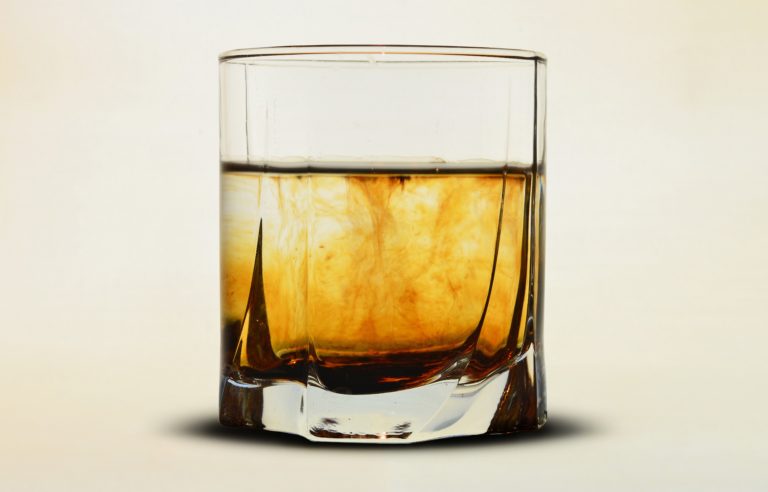After making a glass of whiskey this evening, I noticed how cloudy it turns after I put my ice in. I’ve always wondered why this happens, so I did a little research. Here’s what I found:
Whiskey turns cloudy because it is filled with fatty acids, esters, and proteins that dissolve in alcohol, but not in water. Therefore, as the alcohol content drops, due to evaporation or dilution (via ice or water), these substances begin to separate and clump together, giving the whiskey a hazy appearance. This separation can also be caused by chilling the whiskey, especially below freezing point (32°F/0°C).
Is it safe to drink cloudy whiskey?
Yes, it is safe to drink cloudy whiskey. If your fresh glass of whiskey on the rocks appears cloudy or hazy, that is totally normal and can be consumed without a second thought. While whiskey can go bad, if it is in the bottle prior to drinking, it is extremely unlikely that it will. Even very old whiskey will usually still be safe to drink, but it may not taste as good.
If the whiskey has been left out for awhile or overnight and appears muddy looking, it has likely oxidized. While oxidized whiskey likely won’t make you sick, it can cause irritation and probably won’t taste very good. If you’re concerned about your whiskey being bad, take a small taste. If it tastes normal, or milder than usual, that is fine to drink. However, get rid of the whiskey if it has a sour, metallic, or other strange taste.
To avoid any concerns of spoilage with your whiskey, make sure that you are storing it correctly. This will help ensure that it remains high quality for years to come.
Why does some whiskey get cloudy and some doesn’t?
To avoid cloudiness (and unfounded claims of spoilage from drinkers), some distillers undergo a process called chill filtering on their whiskey. In this process, the whiskey is cooled down to a few degrees below freezing (~28-30°F). This forces the fatty acids and other substances to separate from the whiskey. Then, they filter the cold whisky to separate out those particles and avoid it becoming cloudy in people’s homes later. While this does fix the cloudiness problem, many distillers dislike it because it can affect the flavor and mouthfeel of the whiskey.
Most large distilleries chill filter their whiskey, and nearly all distilleries chill-filter their low-proof offerings (~40-45% ABV). Here is a list of a few chill-filtered and non-chill filtered whiskeys. If you’re trying to find out if your whiskey has been chill filtered, most non-chill filtered whiskey will mention it on the label!
How to avoid cloudy whiskey (and fix it when it happens)?
Although cloudiness has no effect on the taste of the whiskey, some people prefer their drink to be crystal clear for aesthetic reasons. Because whiskey’s cloudiness is driven by its temperature and alcohol content, there are a couple things you can do to avoid clouding your whiskey in the future, and fix it when it does occur.
1. Drink your whiskey neat
Since the molecules that cause cloudiness dissolve in the alcohol, you’ll want to avoid diluting your whiskey with water or other mixers, to ensure that it maintains its high alcohol content.
2. Avoid chilling your drink (with ice or chilled glasses)
Avoid cooling your beverage, especially with ice, to avoid further dilution as well as the separation (and cloudiness) that comes with the lower temperature. If your cold whiskey begins to cloud up, remove the ice or pour into another glass, and allow it to return to room temperature. This should restore its clear appearance.
2. Add more whiskey
Similar to drinking your whiskey neat, you want to avoid diluting your drink. If you believe the cloudiness is being caused by the whiskey being too diluted, add some more whiskey to bring up the overall alcohol content. As long as you don’t continue to add water or cool it down, this should help restore your whiskey to its original clarity.
Conclusion
Whiskey contains a variety of small molecules that separate from the whiskey when cold or diluted, causing it to appear cloudy. This is completely natural and not an indication of flawed or spoiled whiskey. There are a few things that can be done if you want to avoid cloudiness in your whiskey, but personally I am going to keep taking mine over rocks. Cheers!
Whisky Will’s the name and Scotch is my game! I am obsessed with whiskeys, bourbons, and scotches and love to write about them. Whisky Grotto is my playground where I educate the world about whisky, bartending, and more. So, keep sipping your drink and have a good time!


